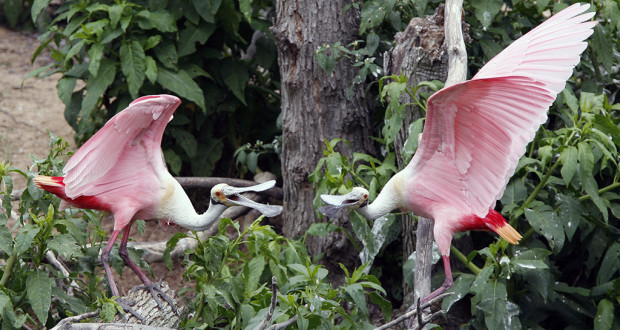During the spring and summer, Great Egrets, Roseate Spoonbills, Neotropic Cormorants and others build nests, breed and raise their families among the twisted limbs and brush on the island.
A gravel road at the entrance leads to a small parking lot. From there, you can take a short trail up to the Rookery or stroll other trails and nearby ponds. Sometimes in the summer, mosquito repellant is as essential as binoculars.
At the end of the trail from the parking lot you climb wooden stairs to a ridge that parallels Claybottom Pond. A large observation deck is the first thing to greet you. From there, you can see the Rookery on your far left, and to the right the marshy end of the pond. Spoonbills, Cormorants and Egrets often will shuttle back and forth, flying past the deck. Walk down the trail to the left and you’ll see a series of smaller decks, closer to the action.
The Rookery is not quite as robust as it was before Hurricane Ike, but it is recovering. There aren’t as many nests on the trail side of the island as there once were. In fact, the trail was closed for a time to encourage more nesting.
The late afternoon and early evening offer both good back light for photography and heavy activity as birds return from the day’s feeding.
Especially in the spring, the Rookery has all the hallmarks of a crowded city tenement: birds coming and going, constant chattering, screaming children and occasionally fights among neighbors. Nests are almost stick-to-stick and piled high in the trees. You’ll see everything from eggs to hatchlings to birds standing on their feet for the first time and preparing to leave the nest. The isolation of the island protects them from many of the predators they’d face in the marsh or forest.
Winnie Burkett describes rhythm of the Rookery and provides some local history on the Houston Audubon site:
Every year is different but in an average year, nesting activity starts in March when Great Egrets start spending the day on the island displaying their gorgeous plumes to try to attract a mate. Snowy and Cattle Egrets, Little Blues and Tricolored Herons, White Ibis, Neotropic Cormorants and Spoonbills soon show up and things get real active and noisy. Herons and egrets don’t exactly make calls but they do make a lot of different noises and as you are watching nest building you will hear some strange ones. Snowy Egrets make a noise that sounds like gargling…. Neotropic Cormorants oink, and some days it sounds just like a barnyard…. By mid-April lots of things are happening, early eggs are hatching, and nest building and displaying are in full swing and you can get a close look at all the activity from the trail around the pond. There is nowhere else in Texas where you can get such a wonderful look at the home life of colonial waterbirds.
SANCTUARY GALLERY













